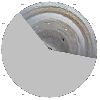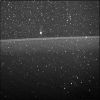Jupiter: the "King" and His Moons
|
|
|

Jupiter-Impact-2010-004.jpgImpact on Jupiter! (from Hubble Space Telescope - edm)54 visiteDiscovered by Australian amateur astronomer Anthony Wesley on Sunday, July 19, 2009, the spot was created when a small object plunged into Jupiter's atmosphere and disintegrated. The only other time in history such a feature has been seen on Jupiter was 15 years ago.
"This is strikingly similar to the comet Shoemaker Levy 9 that impacted Jupiter in July 1994" said team member Keith Noll of the Space Telescope Science Institute in Baltimore, Md.
"Since we believe this magnitude of impact is rare, we are very fortunate to see it with Hubble" added Amy Simon-Miller of NASA's Goddard Space Flight Center in Greenbelt, Md. She explained that the details seen in the Hubble view shows a lumpiness to the debris plume caused by turbulence in Jupiter's atmosphere. The spot is presently twice the length of the United States.
Simon-Miller estimated that the diameter of the object that slammed into Jupiter was at least the size of several football fields. The force of the explosion on Jupiter was thousands of times more powerful than the suspected comet or asteroid that exploded over the Tunguska River Valley in Siberia in June 1908.
The WFC3, installed by the STS-125 astronauts in May, is not yet fully calibrated. So while it is possible to obtain celestial images, the camera's full power cannot yet be realized for most observations. The WFC3 can still return meaningful science images that will complement the Jupiter pictures being taken with ground-based telescopes.
This is a Natural Color image of Jupiter as seen in Visible Light.
Credit: NASA, ESA, and H. Hammel (Space Science Institute, Boulder, Colo.), and the Jupiter Impact Team
The members of the Jupiter Impact Team are:
Dr. Heidi B. Hammel (Space Science Institute, Boulder, Colo.)
Dr. Amy Simon-Miller (NASA's Goddard Space Flight Center, Greenbelt, Md.)
Dr. Keith S. Noll (Space Telescope Science Institute, Baltimore, Md.)
Dr. Michael H. Wong (Space Telescope Science Institute, Baltimore, Md.)
Prof. John T. Clarke (Boston University, Boston, Mass.)
Prof. Imke de Pater (University of California, Berkeley, Calif.)
Dr. Glenn S. Orton (Jet Propulsion Laboratory, Pasadena, Calif.)
Dr. Agustin Sanchez-Lavega (University of the Basque Country, Spain)
CONTACT
Dwayne Brown
HQ, Washington
202-358-1726
dwayne.c.brown@nasa.gov
Ray Villard
Space Telescope Science Institute, Baltimore, Md.
410-338-4514
villard@stsci.eduMareKromium
|
|

Jupiter-Impact-2010-005.jpgAnother Impact on Jupiter?89 visiteUN ALTRO BOLIDE ("FIREBALL") su Giove?
il giorno 20 Agosto 2010, alle ore 18:22 UT, un Astrofilo Giapponese, Masayuki Tachikawa, della città di Kumamoto, ha video-registrato quello che SEMBRA ESSERE l'aftermath di un impatto occorso sul Pianeta Giove.
Se l'ipotesi dell'impatto venisse confermata, questa sarebbe la terza volta in soli 13 mesi che gli Astrofili del Mondo intero rilevano segni di impatti su Giove. Gli eventi precedenti si sono verificati il 19 luglio 2009 ed il 3 Giugno 2010.
La maggiore speculazione che infiamma le più recenti discussioni riguardanti questo fenomeno ritiene che Giove possa essere colpito da bolidi (ed asteroidi?) assai più spesso di quanto si fosse finora ritenuto.
E' (anche) per questo motivo che svariati Ricercatori insistono a chiedere la creazione di una rete mondiale di telescopi destinati a monitorare costantemente il Gigante Gassoso e quindi (laddove possobile) a misurare le velocità d'impatto.
"Come l'evento del 3 giugno u.s., questo bolide non ha prodotto alcun residuo visibile", osserva comunque il Dr John Rogers, Direttore della sezione Giove della British Astronomical Association.MareKromium
|
|

Jupiter-Impact-2010-006.jpgAnother Impact on Jupiter?73 visiteAlcune immagini ad Alta Risoluzione scattate prima e dopo l'Evento Anomalo (impatto?) che ha coinvolto il Pianeta Giove.
Così come commentano gli Osservatori (che, come potete vedere, hanno ripreso il Gigante da svariate località), non c'era nessun segno visibile sul Gigante (nè in RGB, né UV, né Metano) il quale facesse da "testimone" della verificazione di un impatto.
Infatti, a parte le ben visibili turbolenze che usualmente caratterizzano l'Alta Atmosfera Gioviana e la chiara di una macchia scura circolare (si tratta dell'ombra di uno dei Satelliti Galileiani - probabilmente Ganimede), non vi è traccia alcuna di "cicatrici atmosferiche" le quali possano far supporre l'avvenuta verificazione di un Evento d'Impatto.MareKromium
|
|

Jupiter-Impact-2010-007.jpgAnother Impact on Jupiter?66 visiteUn'altra immagine della "Fireball" che ha impattato Giove il giorno 20 Agosto u.s.
In questo caso si tratta di una ripresa effettuata dall'Astrofilo Giapponese Aoki Kazuo, da Tokio, il quale ha registrato un flash che, per coordinate spazio-temporali, coincide con quello rilevato e ripreso dall'altro Astrofilo del Sol Levante, Masayuki Tachikawa, che osservava il Gigante Gassoso dalla città di Kumamoto (la quale è distante circa 800 Km da Tokio).MareKromium
|
|

Jupiter-Impact006-ALPO.gifEvolution of the Impact on Jupiter (GIF-Movie)54 visiteDa "NASA - Picture of Day" del giorno 8 Settembre 2009:"Two months ago, something unexpected hit Jupiter.
First discovered by amateur astronomer Anthony Wesley on 2009 July 19, the impact was quickly confirmed and even imaged by the Hubble Space Telescope the very next day. Many of the world's telescopes then zoomed in on our Solar System's largest Planet to see the result.
Some of these images have been complied into the above animation. Over the course of the last month and a half, the above time-lapse sequence shows the Dark Spot - first created when Jupiter was struck - deforming and dissipating as Jupiter's clouds churned and Jupiter rotated.
It is now thought that a small comet -- perhaps less than one kilometer across -- impacted Jupiter on or before 2009 July 19. Although initially expected to be visible for only a week, astronomers continue to track atmospheric remnants of the impact for new information about winds and currents in Jupiter's thick Atmosphere".MareKromium
|
|

Jupiter-Impact02.jpgImpact on Jupiter!54 visitenessun commentoMareKromium
|
|

Jupiter-Impact04-PIA12147.jpgImpact on Jupiter!54 visitenessun commentoMareKromium
|
|

Jupiter-Impact05-PIA12148.jpgImpact on Jupiter!54 visitenessun commentoMareKromium
|
|

Jupiter-Juno-Lightning_Green.jpgGreen Light on Jupiter81 visiteIf that "Green Thing" is a true Lightning, then it is a VERY funny-looking one. But we are on Jupiter and so, everything is possible! At least, so the Scientists said, swearing on the Third Newton's Law.MareKromium
|
|

Jupiter-Juno-Rings.jpgFrom inside the Rings95 visitenessun commentoMareKromium
|
|

Jupiter-NO-00-022807_3.jpgJupiter! (after New Horizons' Fly-By)53 visitenessun commentoMareKromium
|
|

Jupiter-PIA01384.jpgThe Great Red Spot, from Voyager 155 visiteOriginal caption:"This view of Jupiter was taken by Voyager 1. This image was taken through color filters and recombined to produce the color image.
This photo was assembled from three black and white negatives by the Image Processing Lab at Jet Propulsion Laboratory".
|
|
| 318 immagini su 27 pagina(e) |
 |
 |
 |
 |
 |
21 |  |
 |
 |
 |
|

